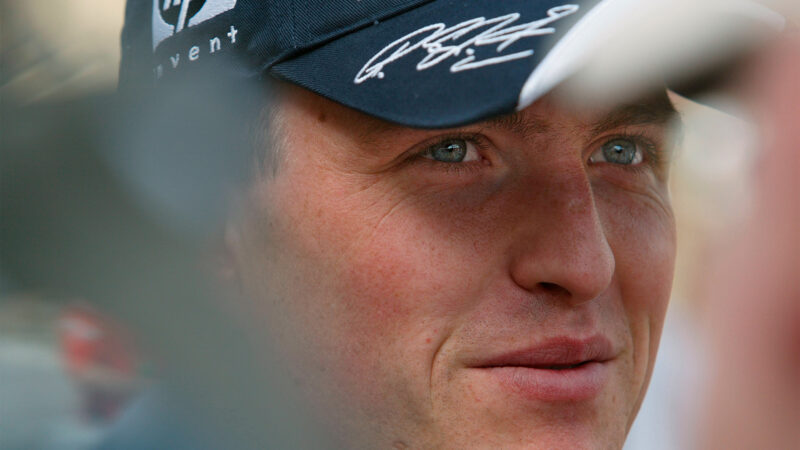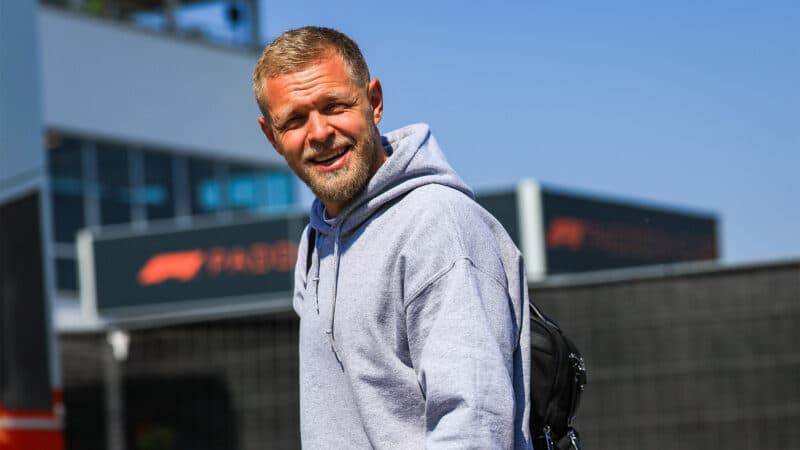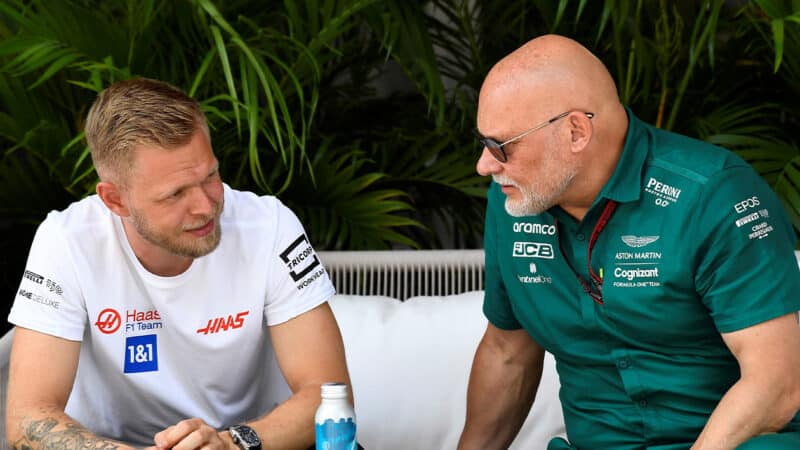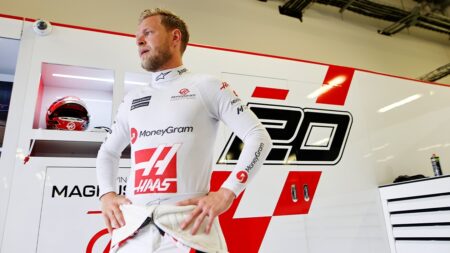Even so, I was sad to read it, and I was touched by his plucky reaction when inevitably he was quizzed about it by the F1 media in the Hungaroring paddock: “Would I have liked to continue here [at Haas]? I think, you know, had I continued, it would have been cool to see, you know, the fruits of the momentum that’s been built here recently. That would’ve been interesting, but I think there’s also other interesting projects out there, and there’s still seats available in F1. So, right now, I think the best thing is just to focus on doing good races and being in contention for the seats available, and things will fall into place eventually.”
The following quote was included in the Haas press statement, attributed to team principal Ayao Komatsu: “I’m hoping we can find a way to keep working together in some capacity. We can hopefully define that in the near future, but his [Magnussen’s] extensive experience in F1 and his knowledge of our working operations are undoubtedly of value in our ongoing growth and development.”
Among the many drivers with whom I have worked in my long F1 career, Magnussen is without doubt the most passionately besotted with racing for racing’s sake. Moreover, having tried my best to cheer him up in what was for him an annus horribilis, 2015, when he was bored and frustrated in the role of McLaren’s F1 reserve driver, I fervently hope that he does not agree to take on the kind of quasi-managerial role to which Komatsu has apparently alluded. Let’s be blunt. Kevin is an old-school racer. As I say, his racing hero is Stirling Moss, who retired 30 years before he was born. Many times, over a coffee or a beer, I have held his rapt attention by reeling off the stories I know so well and love so much, about Antonio Ascari, Tazio Nuvolari, Achille Varzi, Bernd Rosemeyer, Rudolf Caracciola, B Bira, Alberto Ascari, Juan Manuel Fangio, Stirling Moss, Jim Clark, Graham Hill, Jackie Stewart, Jochen Rindt, Ronnie Peterson, James Hunt, Carlos Reutemann, Mario Andretti, Gilles Villeneuve, Ayrton Senna, Michael Schumacher, Mika Hakkinen, and many more. He absolutely loves all that. By contrast the only aspect of 21st-century F1 that he genuinely enjoys is the bit in the cockpit, even though he has raced a podium-worthy F1 car only once, in his first ever grand prix, since when he has started 175 more, the highlights being four fifth places.

Magnussen celebrates a podium on his grand prix debut
Grand Prix Photo
He is still only 31. It is not impossible that he will land himself an F1 drive for 2025, but it is unlikely. What he can do, and should therefore embrace doing instead, is to wave a fond farewell to F1 and set sail on the next voyage of his racing odyssey. Whether you be a driver, an engineer, a mechanic, a journalist, a photographer, a comms/PR exec, a marketer, or whatever, there really is life after F1, as I now know. It is difficult to see that truth when you are still immersed in F1’s gurgling cauldron, but a truth it is. The British Touring Car Championship is nowhere near as glamorous as F1, but the work that I do for my comms/PR agency requires me to attend the odd BTCC race, and I relish doing so. An old F1 saying has it that you meet a better class of person at the back of the grid. I would put it slightly differently: you meet a less remorselessly ruthless kind of person at the back of the grid. In the BTCC there is no such gradation. A piranha club the BTCC is not. To be clear, I am not, repeat not, tipping Magnussen as a future BTCC driver; no, I am saying that he will enjoy himself in a bright, carefree and uncomplicated way when next year he enters, and reminds himself of the pleasure of winning races in, whatever non-F1 series he selects.
And Ralf Schumacher? I know him far less well than I know Kevin Magnussen, although I have known Ralf for much longer. I took over the editorship of F1 Racing magazine in December 1996, which meant that the first F1 grand prix to be run in my 11-year spell in the editor’s chair was the 1997 Australian Grand Prix, which was Schumi Jr’s debut F1 race. I first met him at Imola seven weeks later, where I argued with him for the first time, our bone of contention being the arrangements for a photoshoot. I lost patience with him again six years later when, so unpublishably bland were his answers to my questions about his chances of winning the 2003 world championship for BMW-Williams that I excused myself and aborted our interview after 11 of our allotted 30 minutes. And, rather more (in)famously, I lost my temper with him altogether when, four years after that, at Indianapolis in 2007, by which time he was an unhappy albeit very well paid Toyota driver in the departure lounge of his F1 career, I swore at him when, again, he caused problems during a photoshoot. I regret that. It was rude of me.
The reason why he was suddenly a subject of media attention in Budapest last Thursday was that he had just come out as being in a same-sex relationship. I found his Instagram post very touching, for it was modest, generous, and loving: “The most beautiful thing in life is when you have the right partner by your side with whom you can share everything,” he wrote, the accompanying photograph an image of him with his arm around his partner, Etienne, looking out together at a calm and pretty seascape.
View this post on Instagram
The reaction from F1 drivers, F1 team principals, and indeed the whole F1 community, including media and fans, was overwhelmingly supportive. Granted, inevitably, a few bigots took to social media to spread a bit of homophobic poison, but I hope that neither Ralf nor Etienne was too upset by their rantings. As a gay man who has been ‘out’ in F1 circles for decades, I know all too well that reading homophobic insults is part and parcel of having a social media presence in F1. You get used to it, even though it still sometimes has the power to wound.
As Lewis Hamilton suggested in his typically wise and kind reaction to Schumacher’s announcement, the LGBTQ+ element of Ralf’s personality is unlikely to be a new discovery for him. Ralf is 49, after all. Moreover, as long as 25 years ago there were rumours rife in the F1 paddock about his sexuality — yet, despite the fact that journalists are often derided alongside politicians, bankers, lawyers, and estate agents as members of one of the least trusted professions, I feel proud of us as a collective to be able to state with confidence that the sexual scuttlebutt about Ralf never made its way into print in any reputable or mainstream F1 magazines or websites.
Nonetheless, back in the day, some F1 folk used to ask me silly questions about the subject, the daftest usually along the following lines: “How come you and Ralf don’t get on when you’re both gay?” Well, first of all, we did not and still do not know that Ralf is specifically gay per se. All we can accurately say is what he himself has revealed, which is that he is in a loving relationship with a man. I think we can state with safety that he is LGBTQ+ therefore. But it was a foolish question besides that: first, he was not ‘out’ at the time, and, second, our disagreements had nothing to do with either his sexual preferences or mine. Ralf was generally grumpy back then, truth be told, and I guess that may in part have been a result of the burden of secrecy he was carrying. But I do not know that.

In 180 starts, Schumacher scored 27 podium finishes, six pole positions and six race wins
Grand Prix Photo
I doubt that he now wants to become a trailblazer for LGBTQ+ rights, equality, and inclusion, and he does not have to be if he does not want to be. Nonetheless, his coming-out is important, because he is only the fourth driver in the 75-season history of F1 who we know to be or have been LGBTQ+, and he is the first to have publicly declared himself as such. Moreover, he was a successful F1 driver — a six-time grand prix winner no less — and his super-famous surname undeniably adds weight to his stature within the sport. (The other three F1 drivers whom we know to have been LGBTQ+ were Nicha Cabral, Mike Beuttler, and Lella Lombardi, who are all sadly no longer with us.)
Even if Ralf does not become an LGBTQ+ trailblazer, which as I say I do not expect him to, the act of his coming-out, and the hugely positive way in which his announcement was welcomed by F1 stars past and present, will inevitably have the effect of making more LGBTQ+ people, including young LGBTQ+ people, feel that they belong in F1 — as drivers, as engineers, as mechanics, as journalists, as photographers, as comms/PR execs, as marketers, and of course, last but very far from least, as fans. Or, to put it another way: if you can see it, you can be it.




